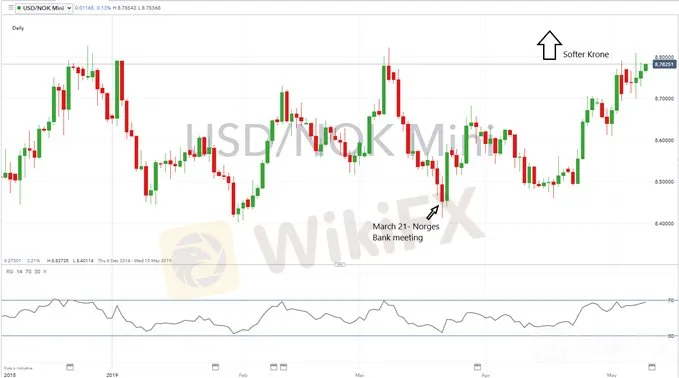简体中文
繁體中文
English
Pусский
日本語
ภาษาไทย
Tiếng Việt
Bahasa Indonesia
Español
हिन्दी
Filippiiniläinen
Français
Deutsch
Português
Türkçe
한국어
العربية
USDNOK Drops as Norges Bank says Rates Will Likely Rise in June
Abstract:The Norwegian Krone is strengthening after Norways central bank left interest rates unchanged but said its policy rate will most likely be increased next month.
NOK Talking Points:
Norges Bank left interest rates unchanged Thursday but said Norwegian rates will most likely be raised next month
That has lifted NOK,which is also supported by a strong Norwegian economy and labour market
However, trade concerns and weakening oil prices could weaken it further ahead
Improved efficiency in the oil and gas industry have increased energy-related investment
The Norwegian Krone received a boost Thursday as a hawkish stance by Norges Bank pointed to a rate hike next month. Coupled with a positive Norwegian economy, both EURNOK and USDNOK weakened even though lingering trade concerns and softening oil prices could threaten the economys expansion.
In March, the Central Bank decided to increase rates by 0.25 percentage points to 1.0%, as economic expansion was stronger than earlier anticipated. Despite leaving rates unchanged in May, Norges Bank has been the outlier to a general dovish stance from central banks and said Thursday that a rate hike is on the cards for its next meeting in June.
How Will Stocks Drop, Crude Oil Prices Impact Norges Bank Policy? – by Dimitri Zabelin, Junior Currency Analyst
NORWAYS OIL INDUSTRY BOOMING
The Norwegian economy has been booming and this is mostly due to an increase in energy-related investments, resulting in inflation rising above the central banks target level. The Norwegian Oil and Gas Association (NOG) has predicted that investment in Norways oil industry will rise by 16% year-on-year to 184.5 billion crowns in 2019, beating previous expectations of 135 billion crowns.
Despite oil prices being as high as $110 per barrel in mid-2014, an unhealthy cost structure across the industry meant that companies were still experiencing negative cash flows. But a recent restructuring in the industry has led to increased efficiency and competitiveness, reducing the breakeven price for Norwegian oil projects to around $25-30 per barrel, well below current market prices for oil. This has led to an increase in energy-related investments, helping to boost the economy and tighten the jobs market.
HIGHER OIL PRICES AND A WEAKER KRONE
Since its previous meeting, the Norwegian Krone has continued to weaken against the US Dollar, something that Norges Bank was not anticipating. Additionally, oil prices have increased since its last policy meeting in March. Both these factors strengthen the chances of the central bank increasing rates in the second quarter of 2019, but the focus will be on the development of trade talks and recent softening oil prices, which could have the potential to turn the Norges Bank slightly more dovish.
USDNOK DAILY PRICE CHART: THE KRONE HAS SOFTENED

OIL PRICE DAILY CHART: OIL PRICES HAVE CONTINUED TO RISE

Source: IG
Disclaimer:
The views in this article only represent the author's personal views, and do not constitute investment advice on this platform. This platform does not guarantee the accuracy, completeness and timeliness of the information in the article, and will not be liable for any loss caused by the use of or reliance on the information in the article.
Read more

Upbeat U.S. GDP Spurs Dollar Strength
The U.S. GDP released yesterday surpassed market expectations, which has tempered some speculation about a Fed rate cut and spurs dollar's strength.

Oil Price Soar on Geopolitical Tension
Geopolitical tensions in both the Middle East and Eastern Europe have escalated, oil prices surged nearly 3% in yesterday's session. creating significant unease in the broader financial markets.

BoJ Holds Firm on Tightening Path Fuels Yen
The Bank of Japan (BoJ) remains on course with its monetary tightening policy, according to the BoJ Chief, following his hearing at the Japan Lower House.

Eye on Today’s FOMC Meeting Minutes
Wall Street took a pause in the last session, with all three major indexes remaining relatively flat as investors awaited the highly anticipated FOMC meeting minutes.
WikiFX Broker
Latest News
The Withdrawal Trap: How Scam Brokers Lure Victims into Paying More
FCA to Investors: Think Twice Before Trusting These Brokers
Trump\s tariffs: How could they affect the UK and your money
Trump gambles it all on global tariffs he\s wanted for decades
TradingView Brings Live Market Charts to Telegram Users with New Mini App
Trump tariffs: How will India navigate a world on the brink of a trade war?
Interactive Brokers Launches Forecast Contracts in Canada for Market Predictions
Authorities Alert: MAS Impersonation Scam Hits Singapore
Stocks fall again as Trump tariff jitters continue
IG Group Acquires Freetrade for £160M to Expand UK Investment Market
Currency Calculator







